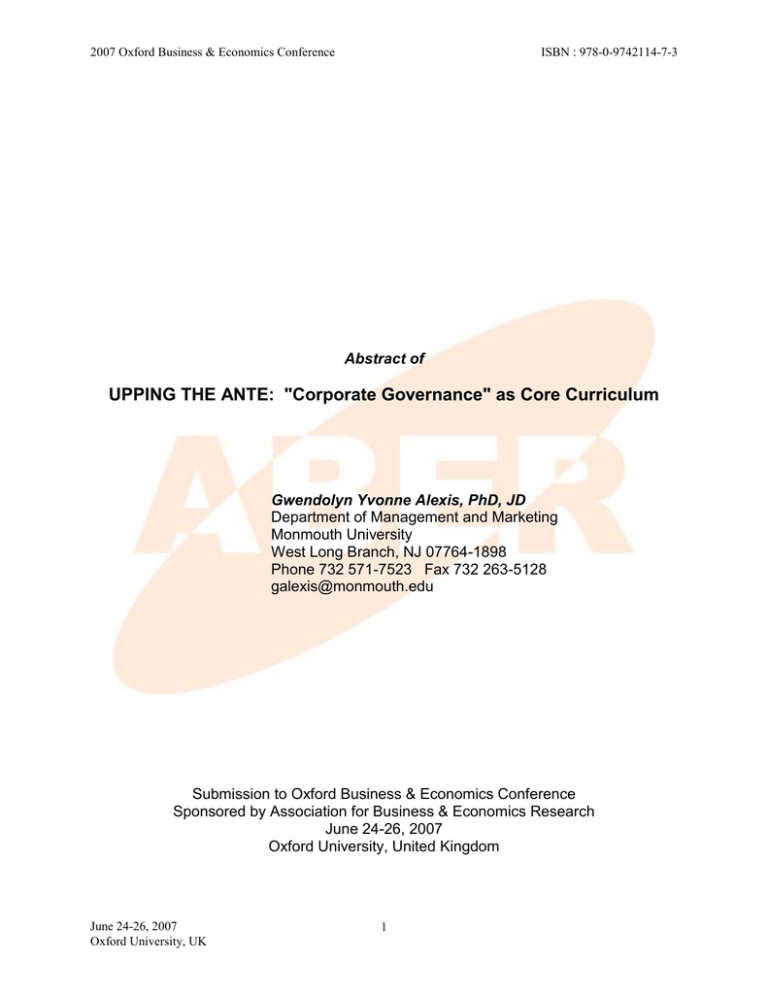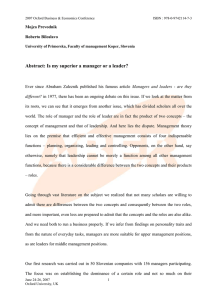UPPING THE ANTE: "Corporate Governance" as Core Curriculum
advertisement

2007 Oxford Business & Economics Conference ISBN : 978-0-9742114-7-3 Abstract of UPPING THE ANTE: "Corporate Governance" as Core Curriculum Gwendolyn Yvonne Alexis, PhD, JD Department of Management and Marketing Monmouth University West Long Branch, NJ 07764-1898 Phone 732 571-7523 Fax 732 263-5128 galexis@monmouth.edu Submission to Oxford Business & Economics Conference Sponsored by Association for Business & Economics Research June 24-26, 2007 Oxford University, United Kingdom June 24-26, 2007 Oxford University, UK 1 2007 Oxford Business & Economics Conference ISBN : 978-0-9742114-7-3 Upping the Ante ….. Abstract of UPPING THE ANTE: "Corporate Governance" as Core Curriculum Already a big draw in executive education programs, Corporate Governance ("CG") is swiftly outgrowing its tangential status in the business school curriculum. Although it is currently relegated to being taught as a subtopic under courses that are already established staples of the business school curriculum, CG is receiving top billing on the agendas of an increasing number of curriculum committees. The trajectory of corporate wrongdoing since the last quartile of the 20th Century has led lawmakers and regulators to up the ante for business executives who stand idly by while fraudulent corporate activities take place during their watch. Reflecting this trend of up-the-ladder accountability, the Sarbanes-Oxley Act of 2002 ("SARBOX") establishes the board of directors as an internal corporate watchdog vis-à-vis management. This legislative uncoupling of board and management interests means it is no longer feasible to cover the topic of corporate governance (now clearly within the purview of the board of directors) as a substrata of topics taught from a managerial perspective--as are the core courses in Management and Marketing that generally encompass the topic of corporate governance. The entrepreneurial emphasis of courses such as "Strategic Management" is clearly not conducive to engaging students in an evolving oversight/management dialectic that is regenerating corporate culture. In this new corporate environment, a board that second-guesses management is not viewed as being obstreperous; rather it is credited with fulfilling its fiduciary obligations to the corporation's shareholders. June 24-26, 2007 Oxford University, UK 2 2007 Oxford Business & Economics Conference ISBN : 978-0-9742114-7-3 In addition to the limitations of the managerial perspective as a basis for exploring CG issues, other factors point to the need for CG to become an autonomous business school offering. In this post-Enron era, corporations are being held accountable to a wide array of societal stakeholders--the investing public, consumers, environmental activists, as well as governments (foreign and local) in parens patriæ for diverse publics. Therefore, it is important to make business students aware that social and political forces can come to bear on the entrepreneurial decision-making process despite the fact that it is inexorably economic in nature. The free-standing CG course is and ideal vehicle for infusing the business school curriculum with the needed social sciences perspective as a complement to the current business school emphasis on market-based epistemology. How would a model CG course look? The objective of the course would be to equip students to take on the responsibilities of a director or trustee of a for-profit or not-for-profit corporation. Under SARBOX, the board is charged with hiring the outside auditor, overseeing the corporate financial reporting process, and critically assessing the sufficiency of internal controls such as a company's conflict-of-interest and whistleblowing policies. Therefore, the provisions of SARBOX, along with the U.S. Sentencing Guideline (mandated by SARBOX) that sets forth a model Ethics Program, provide valuable guidance as to what should comprise the content of a CG course. Additionally, the U.S. Securities and Exchange Commission, the New York Stock Exchange and the Chicago Board of Trade have all adopted rules that constitute best practices for the boards of companies with publicly traded stocks, and these rules provide the cornerstones for structuring a CG course. June 24-26, 2007 Oxford University, UK 3 2007 Oxford Business & Economics Conference ISBN : 978-0-9742114-7-3 What qualifications and experience are required to teach a CG course? Law schools have long covered the topic of corporate governance as part of a "Corporations" course --a core course in the law school curriculum. The emphasis is on the legal implications of doing business as a corporate fiction rather than as a sole proprietorship or a partnership. Therefore, law students are taught the advantages and disadvantages of operating under a state charter and being governed by a board of directors that must adhere to specific corporate by-laws and articles of incorporation. One of the advantages of the corporate form that is dealt with in detail in a law school Corporations course is the ability to finance a corporate venture with other people's money through the sale of a company's stock (as ownership interests). Hence, legal training provides a solid background in the functioning of corporate boards and the ethical dilemma presented by the separation of ownership from control that occurs with the corporate form of transacting business. Lawyers, therefore, possess the educational background and the required expertise to teach a CG course and to integrate the pertinent laws and regulations into the course content. This paper delves into all of the above to (a) argue that a free-standing course in CG should be made part of the required core curriculum in all AACSB accredited business schools; and (b) provide a model CG course with syllabus that is suitable for use in both undergraduate business and MBA programs. June 24-26, 2007 Oxford University, UK 4


